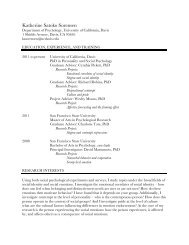SMART Board User's Guide - Psychology
SMART Board User's Guide - Psychology
SMART Board User's Guide - Psychology
You also want an ePaper? Increase the reach of your titles
YUMPU automatically turns print PDFs into web optimized ePapers that Google loves.
Using PowerPoint Software on an Interactive<br />
Whiteboard<br />
Mac<br />
OS X<br />
Win<br />
Mac<br />
Navigate with<br />
Your Finger<br />
<strong>SMART</strong> <strong>Board</strong> tools have been optimized for use with Microsoft PowerPoint software running<br />
on either Windows operating systems or Macintosh computers.<br />
In Windows operating systems, you can write into PowerPoint slides with any Pen Tray<br />
stylus. By default, the stylus writes over top of your PowerPoint presentation. If you like, you<br />
can just move on to the next slide, and the annotations you made over the first slide will<br />
disappear. You have the option, though, of saving the slide with your annotations, either in<br />
PowerPoint software itself or in <strong>SMART</strong> Notebook software.<br />
You can also use the Auto-Save Annotations on Advance setting to automatically save<br />
annotations into the PowerPoint presentation when you move to the next slide. While this<br />
setting spares you the bother of selecting Save to PowerPoint prior to each slide advance,<br />
you still have the option of saving your annotations on selected slides only, or saving<br />
annotations into Notebook software. For more details, see Saving PowerPoint Annotations<br />
on the next page.<br />
NOTE: Macintosh computer users (Mac OS 8.5 though OS X operating systems) only have<br />
the option of saving annotations into <strong>SMART</strong> Notebook software.<br />
When you open PowerPoint software in Slide Show view on an interactive whiteboard, you’ll<br />
notice the following three-button Slide Show toolbar:<br />
Previous Page Next Page<br />
Menu of Commands<br />
Slide Show Toolbar<br />
The two arrow buttons allow you to navigate backward and forward through a PowerPoint<br />
presentation; the middle button provides access to a menu of commands. Alternatively, you<br />
can use the navigational touch shortcuts described below.<br />
Touch Shortcuts for PowerPoint Software Users<br />
When you’re running a PowerPoint slide show on an interactive whiteboard, you can either<br />
use the arrow buttons on the PowerPoint toolbar to navigate through your presentation or use<br />
one of several touch shortcuts (when the styluses are in the Pen Tray):<br />
• To advance your presentation by one slide, double-press anywhere on the board,<br />
making sure your double-press is right-oriented: Press once on the board, and then<br />
press again anywhere to the right of the first press.<br />
NOTE: If you prefer to advance the slide with a single press:<br />
For a Windows operating systems, press the middle button of the Slide Show toolbar<br />
and de-select Settings > Double-Press to Advance.<br />
For a Macintosh computer, press the <strong>SMART</strong> <strong>Board</strong> icon, select Control Panel, press<br />
the Aware tab, and de-select the Double-press to advance to the next slide check<br />
box.<br />
• To reverse your presentation by one slide, use a left-oriented double-press: press<br />
once, move your finger slightly to the left, and then press again.<br />
82 <strong>SMART</strong> <strong>Board</strong> User’s <strong>Guide</strong>
















